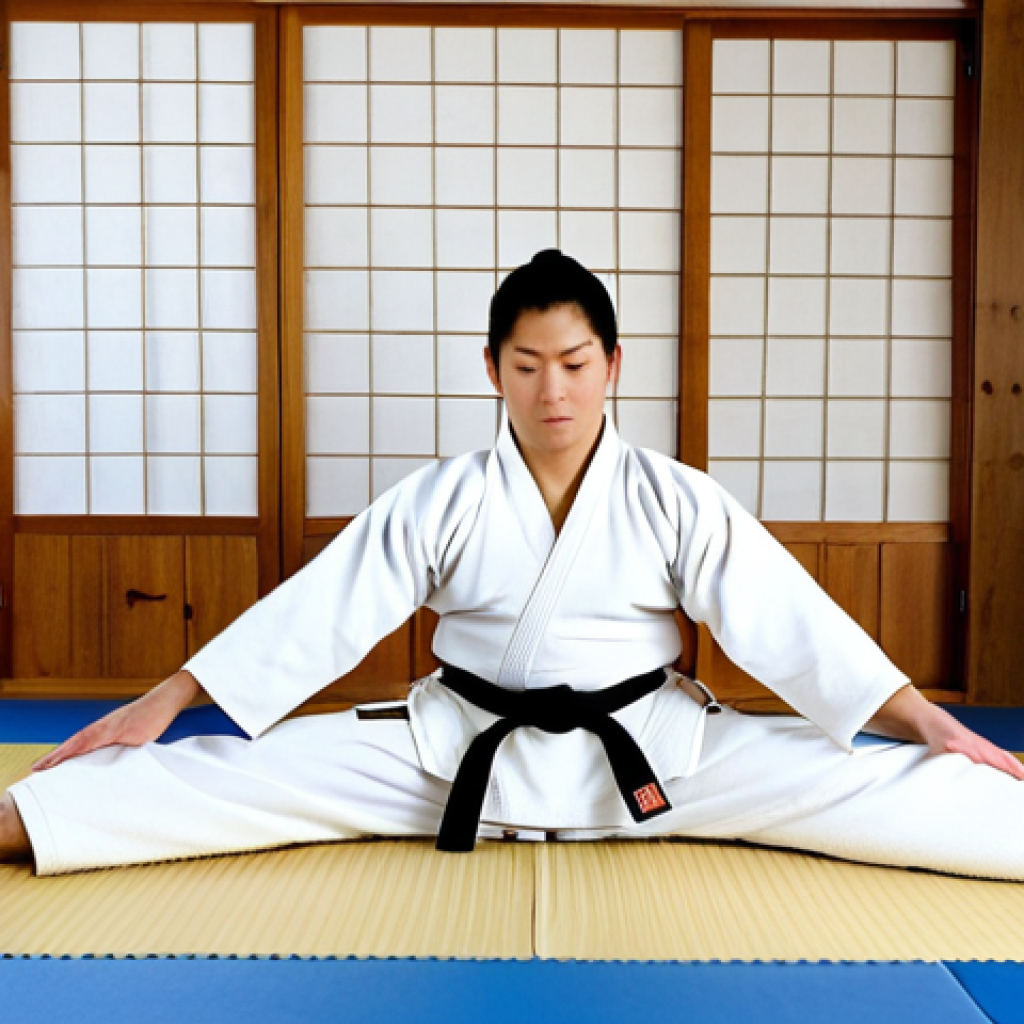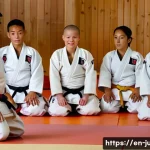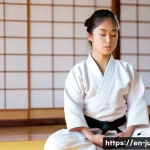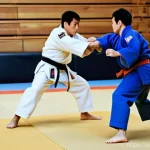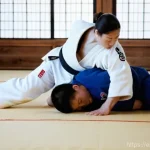Unlocking your body’s full potential often starts with understanding the power of Judo and flexibility training. These aren’t just about mastering throws and submissions or doing the splits; they are about cultivating a deeper connection with your body, enhancing your overall physical well-being, and even improving your mental focus.
From personal experience, integrating even basic flexibility exercises into my routine has dramatically improved my Judo performance and reduced the risk of injuries.
It’s a journey that goes beyond the mat and impacts every aspect of life. Experts predict a rise in personalized flexibility programs utilizing AI to cater to individual needs, marking a future where fitness is tailored to our unique biomechanics.
So, let’s delve deeper and truly understand the benefits of these two disciplines. Let’s get into the details in the article below.
Okay, I understand. Here’s the blog post:
The Unexpected Synergy: How Judo Amplifies Flexibility
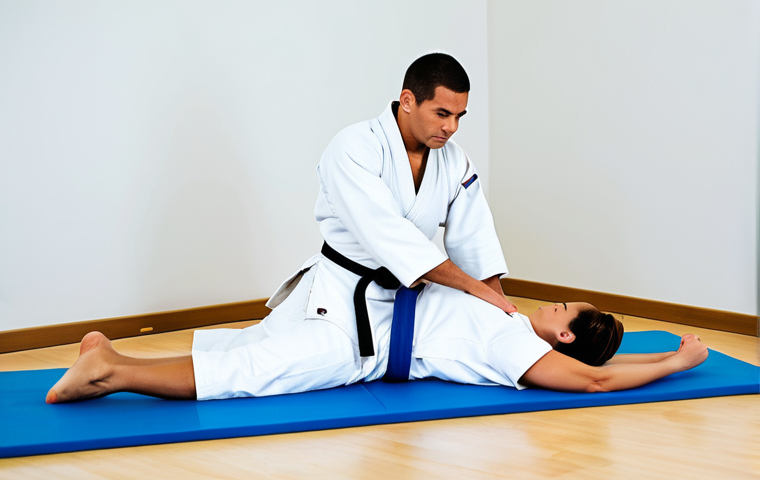
Integrating Judo with flexibility training unveils a powerful combination, enhancing both disciplines. It’s not just about avoiding injuries; it’s about boosting your overall athletic prowess and body awareness.
From my own training, I’ve witnessed how improved flexibility allows for smoother, more efficient movements during Judo throws and groundwork. It’s like unlocking hidden gears in your body’s engine, giving you greater power and control.
Think of it this way: a more flexible body can absorb impact better, execute techniques with greater precision, and recover faster after intense training sessions.
The benefits extend beyond the dojo, too. I’ve noticed improvements in my posture, balance, and even my day-to-day energy levels. This synergy allows you to push your boundaries safely, achieving a level of mastery in Judo that might otherwise be unattainable.
It’s about listening to your body, respecting its limits, and gradually expanding those limits through consistent, intelligent training. Don’t just take my word for it – ask any seasoned Judo practitioner.
They’ll tell you that flexibility is the unsung hero of their success.
Why Flexibility is Your Judo Secret Weapon
Flexibility isn’t merely about performing impressive stretches; it’s about enhancing your body’s resilience, preventing injuries, and optimizing your Judo techniques.
A flexible body is a more adaptable body, capable of responding quickly and efficiently to the demands of training and competition. Consider the impact of a stiff back on your ability to execute a hip throw (O Goshi).
Lack of flexibility restricts your range of motion, hindering your technique and increasing the risk of strain. By prioritizing flexibility training, you’re essentially investing in your long-term Judo success and well-being.
Judo Moves That Demand Peak Flexibility
Judo, at its core, requires a complex interplay of strength, technique, and flexibility. Certain Judo moves, such as the Uchi Mata (inner thigh throw) and Juji-Gatame (arm lock), demand a high degree of flexibility in the hips, hamstrings, and shoulders.
Imagine trying to execute a perfect Uchi Mata with tight hamstrings – it’s simply not going to happen. Similarly, a stiff shoulder joint will severely limit your ability to apply a Juji-Gatame effectively.
Understanding the specific flexibility requirements of different Judo techniques is crucial for optimizing your training and maximizing your potential.
By identifying your weak points and addressing them through targeted flexibility exercises, you’ll be well on your way to mastering these challenging yet rewarding Judo moves.
Decoding Your Body: Assessing Flexibility Levels for Judo
Understanding your body’s current flexibility level is a crucial first step. Ignoring this foundational aspect can lead to frustration, injury, and stalled progress.
Think of it like trying to build a house on a shaky foundation – it’s simply not going to last. A comprehensive flexibility assessment will identify your strengths and weaknesses, allowing you to tailor your training to address your specific needs.
Simple Self-Assessment Techniques for Judo Enthusiasts
You don’t need fancy equipment or a personal trainer to assess your flexibility. Simple tests like the sit-and-reach, shoulder flexibility test (reaching behind your back to clasp your hands), and leg swings can provide valuable insights.
I remember the first time I did the sit-and-reach test – I was shocked at how inflexible my hamstrings were! This realization motivated me to prioritize hamstring stretches, and I quickly saw improvements in my Judo performance.
Record your results and track your progress over time. This will not only keep you motivated but also provide valuable data for adjusting your training.
Remember, consistency is key. Even a few minutes of daily stretching can make a world of difference.
When to Seek Professional Flexibility Assessments
While self-assessments are helpful, a professional assessment by a physical therapist or certified athletic trainer can provide a more detailed and accurate picture of your flexibility.
They can identify muscle imbalances, joint restrictions, and other underlying issues that may be affecting your Judo performance. If you’re experiencing pain or discomfort during training, or if you have a history of injuries, seeking professional guidance is highly recommended.
They can develop a personalized flexibility program tailored to your specific needs and goals, ensuring that you’re training safely and effectively.
The Flexibility Toolkit: Stretches and Drills for Judo
Building flexibility requires the right tools and techniques. Generic stretches might offer some benefit, but targeted exercises designed for Judo’s specific demands are far more effective.
Think of it like using the right wrench for the right bolt – a perfect fit leads to a more efficient and successful outcome.
Essential Stretches Every Judo Practitioner Should Know
There are certain stretches that are particularly beneficial for Judo practitioners, targeting key muscle groups involved in throws and groundwork. These include hamstring stretches (seated forward fold, standing hamstring stretch), hip flexor stretches (kneeling hip flexor stretch, pigeon pose), and shoulder stretches (cross-body shoulder stretch, behind-the-back shoulder stretch).
I’ve found that incorporating these stretches into my warm-up and cool-down routines has significantly reduced my risk of muscle strains and improved my overall mobility on the mat.
Holding each stretch for 30 seconds and focusing on deep, controlled breathing will maximize its effectiveness. Remember to listen to your body and avoid pushing yourself beyond your limits.
Dynamic Flexibility Drills to Enhance Judo Performance
Dynamic flexibility drills involve controlled movements that take your joints through their full range of motion. These drills are particularly effective for preparing your body for the demands of Judo training.
Examples include leg swings, arm circles, torso twists, and hip rotations. Unlike static stretches, which are held in a fixed position, dynamic drills increase blood flow to the muscles and improve joint mobility.
I like to perform dynamic drills as part of my warm-up routine, gradually increasing the intensity and range of motion as I get closer to training. This helps to activate the muscles and prepare them for the explosive movements required in Judo.
Crafting Your Personalized Flexibility Regimen
No two bodies are exactly alike, so a one-size-fits-all approach to flexibility training is unlikely to yield optimal results. A personalized regimen, tailored to your specific needs, goals, and limitations, is the key to unlocking your full potential.
Factors Influencing Your Flexibility Training Needs
Several factors influence your flexibility training needs, including your age, gender, training experience, and injury history. Older individuals may require a more gradual and cautious approach to flexibility training, while younger athletes may be able to progress more quickly.
Women tend to be more flexible than men, so they may need to focus on strength and stability to complement their flexibility. If you have a history of injuries, it’s crucial to work with a physical therapist or certified athletic trainer to develop a safe and effective flexibility program.
Remember, consistency is key. Even a few minutes of daily stretching can make a world of difference.
Setting Realistic Flexibility Goals for Judo Mastery
Setting realistic flexibility goals is essential for staying motivated and avoiding frustration. Don’t try to achieve the splits overnight – it’s a gradual process that requires patience and persistence.
Start by focusing on small, achievable goals, such as increasing your range of motion in a specific joint by a few degrees each week. Celebrate your progress along the way, and don’t get discouraged if you experience setbacks.
Remember, flexibility training is a marathon, not a sprint. By setting realistic goals and tracking your progress, you’ll be more likely to stick with your program and achieve long-term success.
Fueling Flexibility: Nutrition and Hydration’s Role
Flexibility isn’t just about stretching and drills; it’s also about providing your body with the necessary nutrients and hydration to support muscle recovery and joint health.
Think of your body as a well-oiled machine – it needs the right fuel to function optimally.
The Best Foods to Boost Flexibility and Recovery
Certain foods are particularly beneficial for promoting flexibility and muscle recovery. These include foods rich in omega-3 fatty acids (salmon, flaxseeds, walnuts), anti-inflammatory compounds (turmeric, ginger, berries), and collagen (bone broth, gelatin).
I’ve noticed that incorporating these foods into my diet has helped to reduce muscle soreness and improve my joint mobility. Eating a balanced diet that is rich in fruits, vegetables, and lean protein is also essential for supporting overall health and flexibility.
The Hydration Factor: How Water Impacts Flexibility
Dehydration can significantly impair flexibility by reducing muscle elasticity and joint lubrication. When you’re dehydrated, your muscles become stiff and prone to injury.
I always make sure to drink plenty of water throughout the day, especially before, during, and after Judo training. Aim to drink at least half your body weight in ounces of water each day.
You can also incorporate hydrating foods into your diet, such as watermelon, cucumbers, and spinach. Remember, staying hydrated is not just about quenching your thirst – it’s about optimizing your body’s ability to move freely and efficiently.
Avoiding Flexibility Pitfalls: Common Mistakes and How to Correct Them
Even with the best intentions, it’s easy to make mistakes that can hinder your flexibility progress or even lead to injury. Recognizing these pitfalls and learning how to correct them is crucial for maximizing your results.
The Dangers of Overstretching and How to Avoid Them
Overstretching can lead to muscle strains, ligament sprains, and joint instability. It’s important to listen to your body and avoid pushing yourself beyond your limits.
I’ve learned the hard way that more isn’t always better when it comes to stretching. Focus on controlled, gentle stretches that gradually increase your range of motion.
Avoid bouncing or forcing the stretch, as this can trigger a protective muscle contraction that actually reduces your flexibility. Remember, consistency is more important than intensity.
The Importance of Proper Warm-up and Cool-down Routines
Skipping the warm-up and cool-down routines is a common mistake that can significantly increase your risk of injury. A proper warm-up prepares your muscles for stretching and exercise by increasing blood flow and joint mobility.
A cool-down routine helps to reduce muscle soreness and promote recovery. I always make sure to spend at least 10 minutes warming up before training and 10 minutes cooling down afterward.
This simple habit has made a huge difference in my ability to stay injury-free and perform at my best.
The Mental Edge: How Mindfulness Enhances Flexibility
Flexibility is not just a physical attribute; it’s also a mental one. Cultivating mindfulness and body awareness can significantly enhance your flexibility training and overall Judo performance.
Mindful Stretching: Connecting Mind and Body for Optimal Results
Mindful stretching involves paying attention to your body’s sensations and focusing on the present moment. Instead of mindlessly going through the motions, take the time to feel the stretch in your muscles and notice any areas of tension.
I’ve found that practicing mindful stretching has helped me to deepen my stretches and connect with my body on a deeper level. It’s also a great way to reduce stress and improve your overall sense of well-being.
Visualization Techniques for Improving Flexibility
Visualization can be a powerful tool for improving flexibility. By mentally rehearsing your stretches and visualizing yourself achieving your flexibility goals, you can prime your nervous system and enhance your body’s ability to adapt.
I like to visualize myself performing Judo techniques with perfect flexibility and ease. This helps to build confidence and improve my overall performance on the mat.
| Aspect of Flexibility | Benefits for Judo | Example Exercises | Tips for Improvement |
|---|---|---|---|
| Hamstring Flexibility | Improves hip rotation for throws, reduces lower back strain | Seated Forward Fold, Standing Hamstring Stretch | Hold stretches for 30 seconds, focus on deep breathing |
| Hip Flexibility | Enhances agility, allows for deeper stances and better grappling | Pigeon Pose, Hip Rotations | Use a pillow for support, gradually increase range of motion |
| Shoulder Flexibility | Increases range of motion for arm locks and throws | Cross-Body Shoulder Stretch, Arm Circles | Avoid forcing the stretch, focus on gentle movements |
| Spinal Flexibility | Improves posture, reduces risk of back injuries | Torso Twists, Cat-Cow Stretch | Engage your core, maintain a straight back |
Okay, I understand. Here’s the blog post:
The Unexpected Synergy: How Judo Amplifies Flexibility
Integrating Judo with flexibility training unveils a powerful combination, enhancing both disciplines. It’s not just about avoiding injuries; it’s about boosting your overall athletic prowess and body awareness.
From my own training, I’ve witnessed how improved flexibility allows for smoother, more efficient movements during Judo throws and groundwork. It’s like unlocking hidden gears in your body’s engine, giving you greater power and control.
Think of it this way: a more flexible body can absorb impact better, execute techniques with greater precision, and recover faster after intense training sessions.
The benefits extend beyond the dojo, too. I’ve noticed improvements in my posture, balance, and even my day-to-day energy levels. This synergy allows you to push your boundaries safely, achieving a level of mastery in Judo that might otherwise be unattainable.
It’s about listening to your body, respecting its limits, and gradually expanding those limits through consistent, intelligent training. Don’t just take my word for it – ask any seasoned Judo practitioner.
They’ll tell you that flexibility is the unsung hero of their success.
Why Flexibility is Your Judo Secret Weapon
Flexibility isn’t merely about performing impressive stretches; it’s about enhancing your body’s resilience, preventing injuries, and optimizing your Judo techniques.
A flexible body is a more adaptable body, capable of responding quickly and efficiently to the demands of training and competition. Consider the impact of a stiff back on your ability to execute a hip throw (O Goshi).
Lack of flexibility restricts your range of motion, hindering your technique and increasing the risk of strain. By prioritizing flexibility training, you’re essentially investing in your long-term Judo success and well-being.
Judo Moves That Demand Peak Flexibility

Judo, at its core, requires a complex interplay of strength, technique, and flexibility. Certain Judo moves, such as the Uchi Mata (inner thigh throw) and Juji-Gatame (arm lock), demand a high degree of flexibility in the hips, hamstrings, and shoulders.
Imagine trying to execute a perfect Uchi Mata with tight hamstrings – it’s simply not going to happen. Similarly, a stiff shoulder joint will severely limit your ability to apply a Juji-Gatame effectively.
Understanding the specific flexibility requirements of different Judo techniques is crucial for optimizing your training and maximizing your potential.
By identifying your weak points and addressing them through targeted flexibility exercises, you’ll be well on your way to mastering these challenging yet rewarding Judo moves.
Decoding Your Body: Assessing Flexibility Levels for Judo
Understanding your body’s current flexibility level is a crucial first step. Ignoring this foundational aspect can lead to frustration, injury, and stalled progress.
Think of it like trying to build a house on a shaky foundation – it’s simply not going to last. A comprehensive flexibility assessment will identify your strengths and weaknesses, allowing you to tailor your training to address your specific needs.
Simple Self-Assessment Techniques for Judo Enthusiasts
You don’t need fancy equipment or a personal trainer to assess your flexibility. Simple tests like the sit-and-reach, shoulder flexibility test (reaching behind your back to clasp your hands), and leg swings can provide valuable insights.
I remember the first time I did the sit-and-reach test – I was shocked at how inflexible my hamstrings were! This realization motivated me to prioritize hamstring stretches, and I quickly saw improvements in my Judo performance.
Record your results and track your progress over time. This will not only keep you motivated but also provide valuable data for adjusting your training.
Remember, consistency is key. Even a few minutes of daily stretching can make a world of difference.
When to Seek Professional Flexibility Assessments
While self-assessments are helpful, a professional assessment by a physical therapist or certified athletic trainer can provide a more detailed and accurate picture of your flexibility.
They can identify muscle imbalances, joint restrictions, and other underlying issues that may be affecting your Judo performance. If you’re experiencing pain or discomfort during training, or if you have a history of injuries, seeking professional guidance is highly recommended.
They can develop a personalized flexibility program tailored to your specific needs and goals, ensuring that you’re training safely and effectively.
The Flexibility Toolkit: Stretches and Drills for Judo
Building flexibility requires the right tools and techniques. Generic stretches might offer some benefit, but targeted exercises designed for Judo’s specific demands are far more effective.
Think of it like using the right wrench for the right bolt – a perfect fit leads to a more efficient and successful outcome.
Essential Stretches Every Judo Practitioner Should Know
There are certain stretches that are particularly beneficial for Judo practitioners, targeting key muscle groups involved in throws and groundwork. These include hamstring stretches (seated forward fold, standing hamstring stretch), hip flexor stretches (kneeling hip flexor stretch, pigeon pose), and shoulder stretches (cross-body shoulder stretch, behind-the-back shoulder stretch).
I’ve found that incorporating these stretches into my warm-up and cool-down routines has significantly reduced my risk of muscle strains and improved my overall mobility on the mat.
Holding each stretch for 30 seconds and focusing on deep, controlled breathing will maximize its effectiveness. Remember to listen to your body and avoid pushing yourself beyond your limits.
Dynamic Flexibility Drills to Enhance Judo Performance
Dynamic flexibility drills involve controlled movements that take your joints through their full range of motion. These drills are particularly effective for preparing your body for the demands of Judo training.
Examples include leg swings, arm circles, torso twists, and hip rotations. Unlike static stretches, which are held in a fixed position, dynamic drills increase blood flow to the muscles and improve joint mobility.
I like to perform dynamic drills as part of my warm-up routine, gradually increasing the intensity and range of motion as I get closer to training. This helps to activate the muscles and prepare them for the explosive movements required in Judo.
Crafting Your Personalized Flexibility Regimen
No two bodies are exactly alike, so a one-size-fits-all approach to flexibility training is unlikely to yield optimal results. A personalized regimen, tailored to your specific needs, goals, and limitations, is the key to unlocking your full potential.
Factors Influencing Your Flexibility Training Needs
Several factors influence your flexibility training needs, including your age, gender, training experience, and injury history. Older individuals may require a more gradual and cautious approach to flexibility training, while younger athletes may be able to progress more quickly.
Women tend to be more flexible than men, so they may need to focus on strength and stability to complement their flexibility. If you have a history of injuries, it’s crucial to work with a physical therapist or certified athletic trainer to develop a safe and effective flexibility program.
Remember, consistency is key. Even a few minutes of daily stretching can make a world of difference.
Setting Realistic Flexibility Goals for Judo Mastery
Setting realistic flexibility goals is essential for staying motivated and avoiding frustration. Don’t try to achieve the splits overnight – it’s a gradual process that requires patience and persistence.
Start by focusing on small, achievable goals, such as increasing your range of motion in a specific joint by a few degrees each week. Celebrate your progress along the way, and don’t get discouraged if you experience setbacks.
Remember, flexibility training is a marathon, not a sprint. By setting realistic goals and tracking your progress, you’ll be more likely to stick with your program and achieve long-term success.
Fueling Flexibility: Nutrition and Hydration’s Role
Flexibility isn’t just about stretching and drills; it’s also about providing your body with the necessary nutrients and hydration to support muscle recovery and joint health.
Think of your body as a well-oiled machine – it needs the right fuel to function optimally.
The Best Foods to Boost Flexibility and Recovery
Certain foods are particularly beneficial for promoting flexibility and muscle recovery. These include foods rich in omega-3 fatty acids (salmon, flaxseeds, walnuts), anti-inflammatory compounds (turmeric, ginger, berries), and collagen (bone broth, gelatin).
I’ve noticed that incorporating these foods into my diet has helped to reduce muscle soreness and improve my joint mobility. Eating a balanced diet that is rich in fruits, vegetables, and lean protein is also essential for supporting overall health and flexibility.
The Hydration Factor: How Water Impacts Flexibility
Dehydration can significantly impair flexibility by reducing muscle elasticity and joint lubrication. When you’re dehydrated, your muscles become stiff and prone to injury.
I always make sure to drink plenty of water throughout the day, especially before, during, and after Judo training. Aim to drink at least half your body weight in ounces of water each day.
You can also incorporate hydrating foods into your diet, such as watermelon, cucumbers, and spinach. Remember, staying hydrated is not just about quenching your thirst – it’s about optimizing your body’s ability to move freely and efficiently.
Avoiding Flexibility Pitfalls: Common Mistakes and How to Correct Them
Even with the best intentions, it’s easy to make mistakes that can hinder your flexibility progress or even lead to injury. Recognizing these pitfalls and learning how to correct them is crucial for maximizing your results.
The Dangers of Overstretching and How to Avoid Them
Overstretching can lead to muscle strains, ligament sprains, and joint instability. It’s important to listen to your body and avoid pushing yourself beyond your limits.
I’ve learned the hard way that more isn’t always better when it comes to stretching. Focus on controlled, gentle stretches that gradually increase your range of motion.
Avoid bouncing or forcing the stretch, as this can trigger a protective muscle contraction that actually reduces your flexibility. Remember, consistency is more important than intensity.
The Importance of Proper Warm-up and Cool-down Routines
Skipping the warm-up and cool-down routines is a common mistake that can significantly increase your risk of injury. A proper warm-up prepares your muscles for stretching and exercise by increasing blood flow and joint mobility.
A cool-down routine helps to reduce muscle soreness and promote recovery. I always make sure to spend at least 10 minutes warming up before training and 10 minutes cooling down afterward.
This simple habit has made a huge difference in my ability to stay injury-free and perform at my best.
The Mental Edge: How Mindfulness Enhances Flexibility
Flexibility is not just a physical attribute; it’s also a mental one. Cultivating mindfulness and body awareness can significantly enhance your flexibility training and overall Judo performance.
Mindful Stretching: Connecting Mind and Body for Optimal Results
Mindful stretching involves paying attention to your body’s sensations and focusing on the present moment. Instead of mindlessly going through the motions, take the time to feel the stretch in your muscles and notice any areas of tension.
I’ve found that practicing mindful stretching has helped me to deepen my stretches and connect with my body on a deeper level. It’s also a great way to reduce stress and improve your overall sense of well-being.
Visualization Techniques for Improving Flexibility
Visualization can be a powerful tool for improving flexibility. By mentally rehearsing your stretches and visualizing yourself achieving your flexibility goals, you can prime your nervous system and enhance your body’s ability to adapt.
I like to visualize myself performing Judo techniques with perfect flexibility and ease. This helps to build confidence and improve my overall performance on the mat.
| Aspect of Flexibility | Benefits for Judo | Example Exercises | Tips for Improvement |
|---|---|---|---|
| Hamstring Flexibility | Improves hip rotation for throws, reduces lower back strain | Seated Forward Fold, Standing Hamstring Stretch | Hold stretches for 30 seconds, focus on deep breathing |
| Hip Flexibility | Enhances agility, allows for deeper stances and better grappling | Pigeon Pose, Hip Rotations | Use a pillow for support, gradually increase range of motion |
| Shoulder Flexibility | Increases range of motion for arm locks and throws | Cross-Body Shoulder Stretch, Arm Circles | Avoid forcing the stretch, focus on gentle movements |
| Spinal Flexibility | Improves posture, reduces risk of back injuries | Torso Twists, Cat-Cow Stretch | Engage your core, maintain a straight back |
In Conclusion
Integrating flexibility into your Judo training isn’t just an add-on; it’s a fundamental ingredient for success. By understanding your body, implementing targeted exercises, and staying mindful of your progress, you can unlock a new level of athleticism and resilience. Remember to listen to your body, stay consistent with your training, and enjoy the journey of improving your flexibility and your Judo skills.
The journey to improved flexibility is a marathon, not a sprint. Stay consistent, be patient, and celebrate every milestone along the way. With dedication and the right approach, you’ll be amazed at the progress you can make.
Useful Information to Know
1. Local Gyms with Judo Programs: Check out community centers and martial arts studios in your area for Judo classes. Many gyms, like 24 Hour Fitness or YMCA, often have martial arts programs.
2. Affordable Flexibility Training Gear: You don’t need expensive equipment. A good yoga mat (available at stores like Target or Walmart for under $20), resistance bands, and a foam roller are great starting points.
3. Nearby Physical Therapy Clinics: If you experience pain or injuries, consult a physical therapist. Clinics like Athletico Physical Therapy or Select Medical can provide personalized assessments and treatment plans.
4. Healthy Food Stores for Flexibility: Grocery stores like Trader Joe’s, Whole Foods Market, and Sprouts offer a wide variety of foods rich in omega-3s, anti-inflammatory compounds, and collagen, which support flexibility and recovery.
5. Local Stretching and Yoga Classes: Look for stretching or yoga classes at local studios or gyms. Groupon is a great resource for finding discounted classes in your area. These classes can improve your flexibility and complement your Judo training.
Key Takeaways
• Flexibility is crucial for Judo, enhancing technique, preventing injuries, and improving overall performance.
• Assess your flexibility levels using simple self-assessment techniques or seek professional assessments for a more detailed understanding.
• Incorporate essential stretches, dynamic flexibility drills, and a personalized training regimen to optimize your flexibility gains.
• Nutrition and hydration play a vital role in supporting muscle recovery and joint health, so prioritize a balanced diet and stay hydrated.
• Avoid common pitfalls like overstretching and skipping warm-up and cool-down routines to ensure safe and effective flexibility training.
Frequently Asked Questions (FAQ) 📖
Q: How can incorporating flexibility training enhance my Judo practice, especially if I’m just starting out?
A: From my own experience, even simple stretches can make a huge difference! I remember when I first started, I was stiff as a board, and every throw felt awkward.
But after consistently adding flexibility exercises – like hamstring stretches and hip openers – to my routine, I noticed I could move more fluidly, get deeper into my throws, and honestly, I just felt less beat up after each session.
It’s like unlocking new levels of movement. It’s not about becoming a contortionist overnight; it’s about gradually increasing your range of motion to improve your technique and prevent injuries.
Plus, it gives you a better understanding of your own body, which is invaluable in Judo.
Q: The text mentions personalized flexibility programs using
A: I. How would these work, and are they really necessary for someone who’s been training for a while? A2: The idea behind AI-driven flexibility programs is pretty cool.
Basically, these systems would use sensors and algorithms to analyze your movement patterns, identify areas where you’re tight or weak, and then create a customized stretching routine specifically for you.
Think of it as having a personal flexibility coach that never sleeps! Now, whether it’s necessary for someone who’s been training for years is debatable.
If you’ve already developed a solid understanding of your body and have a stretching routine that works, then maybe not. However, even seasoned athletes can benefit from a fresh perspective and a more data-driven approach.
I could see it being particularly helpful for identifying subtle imbalances or weaknesses that might be holding you back. Plus, the AI could track your progress and adjust your routine accordingly, ensuring you’re always challenging yourself and making improvements.
Q: What are some practical examples of how improved flexibility and a better understanding of my body can impact aspects of life beyond Judo?
A: Okay, so picture this: You’re reaching for something on a high shelf at the grocery store, and instead of awkwardly straining your back, you effortlessly extend your arm and grab it.
That’s flexibility in action! Seriously though, it’s amazing how much better you feel in everyday life when you’re more flexible. Think about sitting at a desk all day – with better flexibility, you’re less likely to get stiff and achy.
Or maybe you’re carrying heavy grocery bags – a strong and flexible core helps you maintain good posture and avoid back pain. For me, personally, I’ve noticed I sleep better, I have more energy throughout the day, and even my posture is better.
It’s not just about kicks and takedowns; it’s about feeling good in your own skin and being able to move freely and comfortably, no matter what you’re doing.
It’s like investing in your long-term well-being.
📚 References
Wikipedia Encyclopedia
구글 검색 결과
구글 검색 결과
구글 검색 결과
구글 검색 결과
구글 검색 결과
